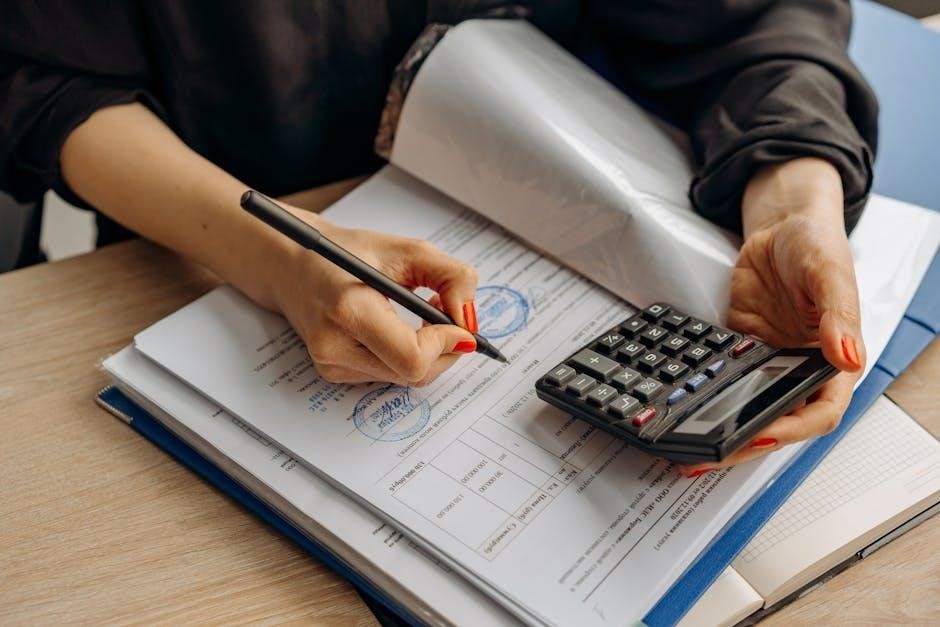Manual verification is a security measure used to review orders before processing. It ensures accuracy, detects fraud, and confirms details like age and address, safeguarding transactions and compliance.
1.1 What is Manual Verification?
Manual verification is a process where orders or requests are reviewed manually by a team to ensure accuracy, compliance, and security. It involves checking details such as age, identity, payment information, and shipping addresses to prevent fraud and errors. This step is crucial for ensuring that all requirements are met before processing, especially in cases where automated systems flag potential issues. Manual verification adds an extra layer of security and helps maintain the integrity of transactions.
1.2 Importance of Manual Verification in Order Processing
Manual verification plays a crucial role in ensuring the security, accuracy, and compliance of order processing. It acts as an additional safety layer to detect fraud, validate customer information, and confirm payment details. This process is essential for preventing unauthorized transactions and ensuring adherence to legal requirements, such as age verification. By manually reviewing orders, businesses can address discrepancies, resolve issues like mismatched addresses, and ensure smooth order fulfillment, ultimately enhancing customer trust and satisfaction.

Key Reasons for Manual Verification
Manual verification addresses several critical factors, including verifying shipping addresses, confirming payment details, ensuring product availability, and validating order accuracy to ensure smooth and secure transactions.
2.1 Fraud Detection and Prevention
Manual verification plays a vital role in fraud detection by reviewing orders flagged as suspicious. This process ensures that billing and shipping addresses match, preventing unauthorized transactions. Additionally, it verifies payment details, reducing fraudulent activities. By manually checking high-risk orders, businesses can safeguard sensitive information and protect customers from potential financial losses. This step is crucial for maintaining trust and security in online transactions, especially for age-restricted products and high-value purchases. It helps prevent chargebacks and ensures compliance with legal regulations.
2.2 Age Verification Requirements
Manual verification is often required to confirm a customer’s age, particularly for age-restricted products like tobacco, alcohol, or vaping devices. This step ensures compliance with legal regulations, such as FDA guidelines, which mandate age verification for certain purchases. Customers may be asked to provide their date of birth or upload identification documents. This process helps prevent underage access to restricted items and ensures businesses remain compliant with legal obligations. It’s a critical step in maintaining regulatory adherence and protecting minors from accessing prohibited goods.
2.3 Payment Verification and Security
Manual verification plays a crucial role in payment security by reviewing transactions for potential fraud. It involves checking if the billing address matches the cardholder’s records and verifying payment details. Some systems charge a small, refundable amount to confirm card validity. This process protects both businesses and customers from fraudulent activities, ensuring secure transactions; It’s especially vital for high-risk orders or when automated systems flag discrepancies. Manual verification adds an extra layer of security, reducing fraudulent chargebacks and building customer trust in payment processes.
2.4 Shipping Address Verification
Shipping address verification is essential to ensure orders are delivered correctly. Manual checks help detect discrepancies between billing and shipping addresses, often flagged for security. This step prevents fraudulent activities, such as unauthorized redirects. Mismatches, like gifts or drop-shipped items, may require additional verification. Sometimes, customers are contacted to confirm their address or provide documentation. This process ensures smooth delivery and customer satisfaction by verifying the intended recipient’s location before processing the order.
2.5 Product Availability and Order Accuracy
Manual verification ensures product availability and order accuracy by cross-checking inventory levels and order details. This step prevents overselling or shipping incorrect items. During verification, teams confirm product specifications, quantities, and pricing to avoid errors. If discrepancies are found, orders may be adjusted or canceled to maintain customer trust. This process ensures that customers receive exactly what they ordered, enhancing satisfaction and reducing return rates by addressing issues before shipment.
2.6 Additional Information Requirements
Manual verification may require customers to provide additional information to complete their orders. This includes identity documents, shipping details, or payment confirmations. Such requirements ensure compliance with legal standards and prevent fraudulent activities. For instance, age-restricted products may need proof of age, while international shipments might require customs documentation. Providing accurate and timely information helps streamline the verification process, ensuring orders are processed efficiently and securely. This step is crucial for maintaining order accuracy and customer trust.

The Manual Verification Process
Manual verification involves reviewing orders for accuracy and security. It includes checking customer details, payment info, and shipping addresses to ensure compliance and prevent fraudulent activities.
3.1 Steps Involved in Manual Verification
The manual verification process begins with order receipt and initial review. Customer details, such as name, address, and date of birth, are cross-checked for accuracy. Payment information is verified to prevent fraud, and shipping addresses are confirmed to avoid mismatches. Product availability is also checked to ensure order fulfillment. If discrepancies arise, the verification team may contact the customer for clarification. Once all details are confirmed, the order is approved for processing and shipping. This step ensures compliance and security.
3.2 How Long Does Manual Verification Typically Take?
Manual verification typically takes a few minutes to several hours, depending on the complexity of the case. Simple checks may resolve quickly, while more detailed reviews require additional time. Factors like weekend processing or high volumes can delay completion. In some cases, manual verification may take up to 24-48 hours if further documentation or clarification is needed. Customers are advised to wait patiently and monitor their order status for updates.
3.3 The Role of Verification Teams
Verification teams play a crucial role in ensuring the accuracy and security of orders. They manually review documents, addresses, and payment details to detect fraud and ensure compliance with regulations. These teams are trained to handle complex cases that automated systems cannot resolve. Their primary responsibilities include verifying customer information, resolving discrepancies, and communicating with customers when additional details are needed. Their efforts ensure smooth order processing and maintain trust between businesses and their customers.

Impact on Customers
Manual verification processes can delay order delivery, causing customer frustration and anxiety. It may require additional information, ensuring security but affecting overall experience.
4.1 What Does “Manual Verification Required” Mean for Customers?
Manual verification required means customers’ orders are paused for additional checks. This ensures age, identity, or payment details are valid, preventing fraud and ensuring compliance with regulations.
4.2 How Manual Verification Affects Order Delivery Times
Manual verification can delay order delivery as it requires additional checks. Orders are paused for review, and processing resumes only after verification is complete. Delays vary depending on the complexity of checks, with most resolving within minutes or days. Customers may experience longer wait times if further information is requested, impacting overall delivery schedules. Communication with verification teams can also extend processing time, ensuring accuracy but slowing down order fulfillment.
4.3 Customer Experience and Emotional Impact
Manual verification can cause frustration for customers due to delayed processing and uncertainty. Receiving requests for additional information may lead to anxiety, especially if documentation is required. The waiting period can create confusion about order status, impacting overall satisfaction. Clear communication from the verification team is crucial to minimize these effects and maintain trust.
4.4 Best Practices for Customers During Manual Verification
During manual verification, customers should remain patient and proactive. Ensure all provided information is accurate and up-to-date. Monitor your email and phone for any follow-up requests. Gather required documents promptly to avoid delays. Clear communication with the verification team can expedite the process. Avoid unnecessary follow-ups unless instructed. Understanding the importance of verification helps maintain trust in the process. Keep track of your order status for updates and follow any instructions provided by the verification team.

Common Scenarios for Manual Verification
Manual verification is often required in e-commerce, legal document checks, voter registration, and financial transactions to ensure accuracy and compliance with regulations.
5.1 E-Commerce Transactions
In e-commerce, manual verification is crucial for addressing discrepancies in billing or shipping addresses, detecting fraudulent activities, and ensuring age compliance. It often involves additional checks on payment details or customer identification to prevent unauthorized transactions. This process helps protect both businesses and consumers by verifying order accuracy and security, especially for high-risk purchases or when automated systems flag potential issues.
5.2 Legal and Document Verification
Manual verification is essential in legal and document processes to ensure authenticity and compliance. It involves reviewing identity documents, contracts, or legal forms to confirm accuracy. In cases where automated systems cannot verify details, human experts step in to validate information. This process is critical in industries like law, finance, and government, where documentation must meet strict legal standards; Manual verification ensures that all requirements are fulfilled, reducing the risk of errors or fraud in sensitive transactions.
5.3 Voter Registration and Election Processes
Manual verification plays a crucial role in voter registration and election processes to ensure integrity and accuracy. It involves reviewing voter applications, verifying identities, and cross-checking details against official records. In cases where automated systems flag discrepancies, manual verification ensures eligibility and prevents fraud. This step is vital for maintaining the legitimacy of elections, especially in scenarios where automated checks are insufficient. It helps uphold the accuracy of voter rolls and ensures lawful participation in democratic processes, safeguarding the electoral system’s credibility.
5.4 Financial Transactions and Loan Applications
Manual verification is essential in financial transactions and loan applications to ensure accuracy and security. It involves reviewing account details, income verification, and identity checks to prevent fraudulent activities. Lenders often require manual verification for high-risk or large-value loans, ensuring compliance with regulations. This process complements automated systems by addressing complex cases, ensuring all documentation meets legal standards, and reducing the risk of errors or misuse of funds. It is a critical step in maintaining financial integrity and customer trust.

Troubleshooting Manual Verification Issues
Manual verification issues often arise from incomplete or incorrect documentation. Resolving these typically involves providing accurate information, such as updated ID proofs or address verification, and clear communication with the verification team to expedite the process.
6.1 Steps to Resolve Manual Verification Problems
Resolving manual verification issues involves reviewing and verifying submitted documents for accuracy. Users should provide additional information if requested, such as ID proofs or address confirmations. Contacting customer support via email or phone can clarify requirements and expedite resolution. Ensuring all details match, like billing and shipping addresses, is crucial. Rectifying mismatches promptly helps avoid delays. Patience is key, as verification teams need time to process and confirm the authenticity of the provided information to complete the order successfully.
6.2 Required Documentation for Verification
Typically, manual verification requires specific documents, such as a government-issued ID, proof of address, and payment confirmation. Copies of identification and recent utility bills are often requested to confirm authenticity. Accurate and legible documentation ensures the process is completed efficiently. Providing all requested materials promptly helps avoid delays. Ensure all details match the order information to prevent further verification issues. Proper documentation is essential for verifying identity, address, and payment details securely.
6.3 How to Communicate with Verification Teams
Effective communication with verification teams involves responding promptly to requests and providing complete, accurate information. Use email, phone, or website forms as instructed. Ensure all required documents are clear and legible. Include order details and reference numbers to expedite the process. Be prepared to answer questions and follow specific instructions. Clear communication helps resolve issues quickly, ensuring verification completes smoothly. Always maintain professionalism and cooperation to facilitate a positive outcome.

Frequently Asked Questions (FAQs)
FAQs address common questions about manual verification, such as what it entails, how long it takes, and whether it can be avoided, providing clarity and reassurance.
7.1 What Happens After Manual Verification is Complete?
Once manual verification is complete, your order is processed for shipping. You’ll receive a confirmation email with tracking details. If approved, the temporary hold is lifted, and your order ships promptly; If issues arise, further documentation or clarification may be requested. Rest assured, the verification team works efficiently to ensure your order is dispatched accurately and securely, maintaining a smooth customer experience.
7.2 Can Manual Verification be Avoided?
Manual verification can sometimes be minimized by ensuring accurate and complete information during checkout. Providing matching billing and shipping addresses, verifying age requirements upfront, and using secure payment methods reduces the likelihood of manual checks. However, certain scenarios, like flagged orders or first-time purchases, may still require manual verification. Customers can avoid delays by reviewing their details carefully before submission, ensuring compliance with verification requirements.
7.3 How is Manual Verification Different from Automated Verification?
Manual verification involves human review of order details, ensuring accuracy and addressing complex issues, while automated verification uses algorithms for quick checks. Manual is slower, handling exceptions, while automated is fast and handles routine checks. Both work together to balance efficiency and security in order processing.
Future Trends in Verification Processes
Future trends in verification processes include the integration of automation, AI, and blockchain for enhanced security and efficiency, alongside global standardization to ensure consistency and compliance.
8.1 The Role of Automation in Verification
Automation is transforming verification processes by reducing manual effort and improving efficiency. Advanced algorithms and AI-driven tools now handle tasks like fraud detection, document validation, and data cross-checking. Automated systems can quickly analyze patterns, flag anomalies, and verify information in real-time, minimizing human intervention. This shift not only accelerates processing times but also enhances accuracy, ensuring compliance with regulations. As technology evolves, automation will play a pivotal role in streamlining verification, making it faster and more reliable than ever before.
8.2 Emerging Technologies for Verification
Emerging technologies like AI, blockchain, and biometrics are revolutionizing verification processes. AI-powered systems analyze data patterns to detect fraud, while blockchain ensures transparency and security in transactions. Biometric verification, such as facial recognition, offers faster and more accurate identity checks. These technologies reduce manual intervention, enhancing efficiency and accuracy. They also enable real-time verification, making processes faster and more reliable. As these technologies advance, they will play a crucial role in modernizing verification, ensuring seamless and secure experiences across industries.
8.3 Global Standardization of Verification Practices
Global standardization of verification practices ensures consistency and compliance across industries. Standardized protocols for documentation, identity checks, and payment verification reduce errors and fraud. Industries like e-commerce and finance adopt uniform guidelines to align with legal requirements and consumer expectations. This harmonization enables smoother international transactions and builds trust. Standardized practices also facilitate easier compliance with regulations, ensuring a balanced approach between global consistency and local legal demands, fostering a more reliable verification ecosystem worldwide.
